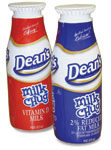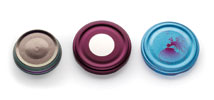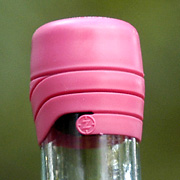
How responding to consumer demands for lighter, stronger and eye-catching closures is the best bet for food and beverage companies during uncertain times.
Closures are a big deal. Even though it may seem like a smaller part of a bigger whole, the closure is as important as a container in terms of keeping a product fresh. And during a time when economic instability is forcing consumers to think twice about a purchase, companies are answering consumer demands for everything from material reduction to tighter sealing to on-shelf appeal.

Phoenix Closures' third generation of Dean's Milk Chug bottle twist cap maintains the same look and capability of the closure's second generation version, but contains 20% less plastic and provides shelf-apparent tamper evidence.
Performing better with less material
Though times are tough and budgets are tight, when faced with a choice between package A and package B, consumers will generally go for the more sustainable package if they’re priced similarly. This is why, even with the cost of petroleum decreasing, companies need to keep lightweighting closures. It benefits the package as a whole.“Certainly, when you go from a 43 millimeter [size] to a 38 or 33, you’re saving a significant amount of weight not only in the closure, but in the container,” says Bill Thomas, director of technology commercialization at Silgan White Cap Americas.
This is especially important with hot-fill polyethylene terephthalate (PET). If weight is taken out of plastic packaging, performance can be decreased and the package may not be able to withstand product temperature.
Silgan is changing the shape and increasing the ribs on the sides of its closures to add some abuse resistance back into a lightweighted closure. According to Thomas, the technology is still being introduced to customers, but in 2009, several applications should be using this technology.
Tetra Pak has also redeveloped two of its brik pack closure types to enhance pouring capabilities while reducing material. The redesigned pre-applied closures will have a 50% larger pouring area, and the post-applied closures will be about 25% larger than before. According to Riccardo Vellani, manager of openings and closures for Tetra Pak, the second generation of post-applied closures will have a 30% opening force reduction, and the targeted weight reduction for both cap types is 20%.
Phoenix, already known for its work with Dean’s in creating its Milk Chug closure, introduced the third generation of the closure last summer. It’s goal was to provide a closure that was more environmentally friendly, delivered improved operating efficiencies and still maintained the premium look and geometry for which the Milk Chug package is known.
Len Ekkert, Phoenix’s vice president of engineering, came up with a design that uses the same visual clues as the previous generation closure, but is produced with more than 20% less plastic. It maintains the same sealing system, but uses its new tamper band system, providing shelf-apparent tamper evidence with the addition of improved application efficiency.

Crown's new closure finishes, including matte, metallic sparkle and a color-changing lacquer, offer customers the ability to differentiate and market a product beyond the label.
Opening up and staying strong
Even if a closure is lightweighted and reinforced to withstand heat, it has to still open easily. This is especially important for children and seniors, two demographics particularly targeted by functional and healthy beverage categories such as juice.PepsiCo released several of its Tropicana orange juice products in a redesigned package with a lightweighted closure from Bapco Closures that increases functionality. Previously sporting a screw cap, the package now has an injection-molded flip-top closure over a foil seal, which allows consumers to open and pour with the snap of a finger and the turn of a wrist.
But just as a closure has to be easy enough to open, it also has to provide a tight enough seal, especially with carbonated beverages.
“The absence of 360 degrees of thread engagement is the number one cause of poor seals in a cap and container marriage,” says Timothy Ferrel, vice president of sales at Phoenix Closures. “To get a full 360 degrees of engagement, the closure manufacturer must design a cap that actually has more than 360 degrees of thread.”
Bericap’s Double Seal closures provide hermetic sealing for carbonated beverages, as well as water, juices, teas and syrups. However, as pressure must be retained, it also must vent appropriately. Bericap introduced its line of HexaLite closures which, at less than 1.5 grams (g), save a minimum of 0.5g of plastic, which allows savings of 2.0g per package.
Bericap also recently won a WorldStar 2008 award from the World Packaging Organisation for its SuperShorty closure, which uses the Double Seal technology, has a venting capacity that has been enlarged to 4.5 volume percent carbon dioxide, allowing consumers to unscrew the cap at excessive speed with less of a risk of it blowing off.

Sidel's oddly-shaped PET beer bottle breaks through the restraints of the traditional glass bottle to offer a package that, when turned upside down and fitted into its overcap, resembles an elegant stem glass.
Matching personalities
There’s more to a closure beyond strength and seal, however. With the economic crisis driving competition to be stronger than ever, food and beverage companies need to make their products stand out. This involves thinking outside of the box and using every part of the package to differentiate, not just the labeling.“We’ve always felt that the closure is a great marketing tool, but just wasn’t being taken advantage of,” says Thomas. “When you have just a plain white closure on a package, you’re really relying on the label to jump out on the shelf.”
Closures have to match a package’s personality. With this in mind, Crown Closures USA recently brought some new ideas to the table, introducing several new finishes to the market, including a matte, metallic sparkle and a special color-changing lacquer that changes with the turn of a package, which can both withstand pasteurized and, in some cases, sterilized filling processes.
It also introduced a special ink to print promotional messages on the inside of metal closures. This is a useful tool to differentiate a product, since it leaves something that cannot be experienced on shelf, further encouraging the customer to purchase the product. Polish juice and jam packager Agros Nova is one of the first companies to use this technology, printing a series of cultural messages inside fruit juice twist caps as part of a brand-building promotion.
Target’s Archer Farms has innovated in the dry cereal category by is using Sonoco’s Linearpak canister, which sports a hinged snap-shut overcap that keeps cereal fresh, eliminating the less reliable paperboard flaps of a typical cereal box. Other companies are following in these footsteps to not only make packages stand out with their closures, but by rethinking the functionality aspect of their closures and bring added value to the package. Here are a couple examples:
• Sidel’s collector’s edition PET beer bottle features an ingenious use of an overcap. The unusually shaped bottle can be turned over, its overcap can be removed and the bottle can be turned upside-down to fit inside the overcap, causing the bottle to resemble a stem glass.
• SpoonLidz single-serve yogurt cup overlid incorporates its own spoon. Referring to itself as a “why-didn’t-anyone-come-up-with-this-sooner” concept, the lid, which is made from renewable cardstock with a sustainable moisture-barrier coating, turns into a spoon with a single fold.
Overall, these new designs show that the closure is a key area where the consumer meets the package.
“Although sometimes overlooked, closures for food and beverage products are the most interactive part of a package, one that can certainly influence how people view a brand,” says Sheila Heath, director of marketing at Crown Closures USA. F&BP
FOR MORE INFORMATION
011-44-1483-243-310 (UK)
909-390-5518
215-698-5100
630-420-4750Sidel
678-221-3000
Silgan White Cap Americas
800-515-1565
SpoonLidz
415-924-0233
Tetra Pak
847-955-6000

WEB EXCLUSIVE: Smarter than your average cork
ZORK USA, a division of Portola Packaging Inc., introduced a solution to put to rest that nagging question every wine bottler asks: “Should I use a cork or a screwcap?”The ZORK closure has three parts: an outer, tamper-evident cap; an inner foil oxygen barrier; and a plunger that pops like a cork and can be easily reinserted.
It eliminates the need for a corkscrew, seals tight enough for the bottle to rest on its side and is recyclable. Adding an extra style incentive for the consumer, the tamper-evident band can be worn as a wristband afterward.
To see a video of consumers trying out the closure and offering their thoughts on it, check outwww.youtube.com/watch?v=rKszET-IWjI&feature=related.
FOR MORE INFORMATION
ZORK USA, a division of Portola Packaging Inc.866-996-9675
